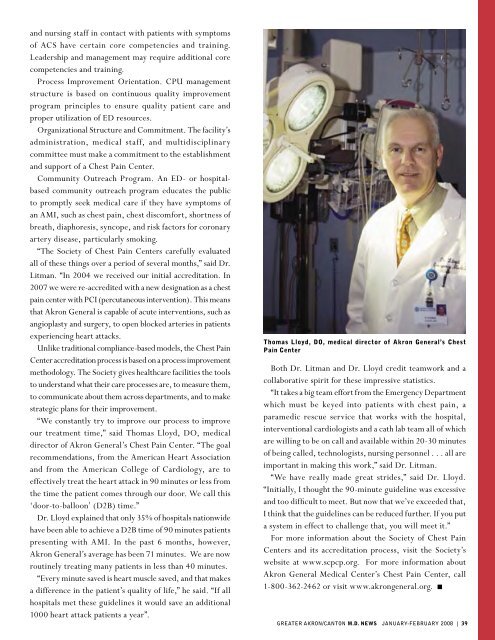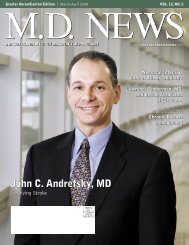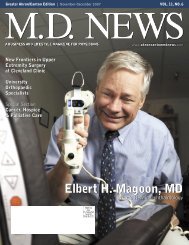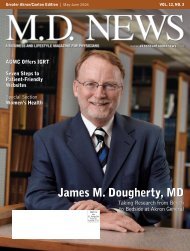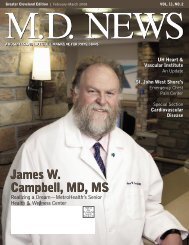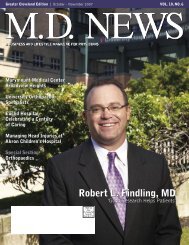Lisa Kohler, MD - AkronCantonMDNews
Lisa Kohler, MD - AkronCantonMDNews
Lisa Kohler, MD - AkronCantonMDNews
Create successful ePaper yourself
Turn your PDF publications into a flip-book with our unique Google optimized e-Paper software.
and nursing staff in contact with patients with symptoms<br />
of ACS have certain core competencies and training.<br />
Leadership and management may require additional core<br />
competencies and training.<br />
Process Improvement Orientation. CPU management<br />
structure is based on continuous quality improvement<br />
program principles to ensure quality patient care and<br />
proper utilization of ED resources.<br />
Organizational Structure and Commitment. The facility’s<br />
administration, medical staff, and multidisciplinary<br />
committee must make a commitment to the establishment<br />
and support of a Chest Pain Center.<br />
Community Outreach Program. An ED- or hospitalbased<br />
community outreach program educates the public<br />
to promptly seek medical care if they have symptoms of<br />
an AMI, such as chest pain, chest discomfort, shortness of<br />
breath, diaphoresis, syncope, and risk factors for coronary<br />
artery disease, particularly smoking.<br />
“The Society of Chest Pain Centers carefully evaluated<br />
all of these things over a period of several months,” said Dr.<br />
Litman. “In 2004 we received our initial accreditation. In<br />
2007 we were re-accredited with a new designation as a chest<br />
pain center with PCI (percutaneous intervention). This means<br />
that Akron General is capable of acute interventions, such as<br />
angioplasty and surgery, to open blocked arteries in patients<br />
experiencing heart attacks.<br />
Unlike traditional compliance-based models, the Chest Pain<br />
Center accreditation process is based on a process improvement<br />
methodology. The Society gives healthcare facilities the tools<br />
to understand what their care processes are, to measure them,<br />
to communicate about them across departments, and to make<br />
strategic plans for their improvement.<br />
“We constantly try to improve our process to improve<br />
our treatment time,” said Thomas Lloyd, DO, medical<br />
director of Akron General’s Chest Pain Center. “The goal<br />
recommendations, from the American Heart Association<br />
and from the American College of Cardiology, are to<br />
effectively treat the heart attack in 90 minutes or less from<br />
the time the patient comes through our door. We call this<br />
‘door-to-balloon’ (D2B) time.”<br />
Dr. Lloyd explained that only 35% of hospitals nationwide<br />
have been able to achieve a D2B time of 90 minutes patients<br />
presenting with AMI. In the past 6 months, however,<br />
Akron General’s average has been 71 minutes. We are now<br />
routinely treating many patients in less than 40 minutes.<br />
“Every minute saved is heart muscle saved, and that makes<br />
a difference in the patient’s quality of life,” he said. “If all<br />
hospitals met these guidelines it would save an additional<br />
1000 heart attack patients a year”.<br />
Thomas Lloyd, DO, medical director of Akron General’s Chest<br />
Pain Center<br />
Both Dr. Litman and Dr. Lloyd credit teamwork and a<br />
collaborative spirit for these impressive statistics.<br />
“It takes a big team effort from the Emergency Department<br />
which must be keyed into patients with chest pain, a<br />
paramedic rescue service that works with the hospital,<br />
interventional cardiologists and a cath lab team all of which<br />
are willing to be on call and available within 20-30 minutes<br />
of being called, technologists, nursing personnel . . . all are<br />
important in making this work,” said Dr. Litman.<br />
“We have really made great strides,” said Dr. Lloyd.<br />
“Initially, I thought the 90-minute guideline was excessive<br />
and too difficult to meet. But now that we’ve exceeded that,<br />
I think that the guidelines can be reduced further. If you put<br />
a system in effect to challenge that, you will meet it.”<br />
For more information about the Society of Chest Pain<br />
Centers and its accreditation process, visit the Society’s<br />
website at www.scpcp.org. For more information about<br />
Akron General Medical Center’s Chest Pain Center, call<br />
1-800-362-2462 or visit www.akrongeneral.org. <br />
GREATER AKRON/CANTON M.D. NEWS JANUARY-FEBRUARY 2008 | 39


